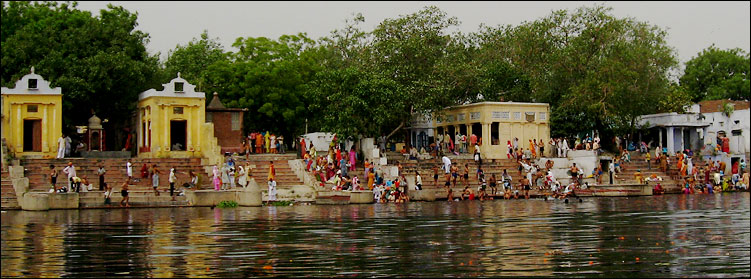
The ghats (June 19, 2007) Two sorts of constructions dominate on the river -- wrestling centres and temples. Sometimes they go together. Many wrestling schools have a temple to Hanuman on their grounds. The burly monkey god is the de facto patron saint of wrestlers even though he carries a weapon -- the mace. Now the that river smells of rotten eggs there understandably aren't quite as many pilgrims as there used to be. But on festivals and new moon days there can still be a decent turnout, or so said the priest at a temple near the river.
Wrestling and Hinduism have a conjoined history, thousands of years old, according to the brothers, whom I met thanks to the boatmen. The family owns several boats “Aren’t the great wrestlers mentioned in the scriptures,” asked Bablu Bhai, the nickname of the priest's younger brother, whose face has a distinctly pugnacious cast to it. “But this traditional martial art is being lost. The courts and lawyers are finishing us off," he said. Both brothers are heavy set with square faces and jaws and full, thick hair. In the Hindu epic the Mahabharat, one of the five Pandava brothers -- the heroes -- is a champion wrestler. In one episode Bhim wrestles for 14 days against an opponent and wins the lengthy bout refereed by Lord Krishna. This seems a little shady to me -- after all wasn't Krishna always on the side of the Pandavas anyway? “Kans too had wrestlers in his court,” said Bablu Bhai, referring to the king who is a Hindu counterpart to Herod. When it was foretold that a young boy would be born who would be his downfall, Kans had all the infant boys slain. But he missed one – a boy born to his imprisoned sister. That boy was Krishna, the naughty god who flirts with all the cowgirls and has left many a broken heart in his wake. And of course who was very fond of the Pandavas. Between the ties to Hinduism and the need for fresh, healthy air and room to exercise, many wrestling centres tend to be located on riverbanks, the brothers explained. In 1905, their grandfather, Guru Charan, brought earth from several pilgrimage sites for the mud wrestling pit that now sits surrounded by a pile of bricks on the ghat. The mud came from Prayag – Allahabad – where the Yamuna and Ganga meet, it came from Varanasi and Haridwar, from Mathura, where legend has it that Krishna was born. It was consecrated by a well-known priest. Then he began training young men in the art of wrestling, in swimming, in physical fitness. Once a week the camp held a wrestling bout between the better wrestlers. Bablu Bhai remembers that in his father's time, a horse-drawn tonga decorated with banners and accompanied by a drummer would go out on Saturday to distribute handbills to drum up attendance for the next day’s match.
The drains (June 17, 2007) When environmentalists talk about the Yamuna being a drain as it goes past Delhi, they really are not exaggerating at all. I always thought the water in the riverbed was part sewage and part river water. Not so. It's all sewage (except for the four months of the monsoon). Where the river enters Delhi there is a a dam. One on side you can see the rapidly flowing muddy brown waters of a fairly clean river. On the other side the of the dam -- called the Wazirabad barrage -- the only river water coming through is seepage. But as you travel south along the river, it fills up again. That water all comes to it from drains. It is a river made entirely of drain water.
Six mighty drains like this join the seepage in the river bed, along with a couple of other smaller ones. This explains that dreadful bubbling of the water, the rotten egg smell. And yet, like at the Ganga, people preserve a faith in the sacredness of any liquid that flows in this space. On Friday, when I returned to the river on a field trip organised by a local environmental group, it was amavasya -- new moon. Many devotees in brightly coloured clothes were all along the ghats. Washing. Bathing. And praying. Watch
a movie on the Yamuna (Quicktime; 4MB; 2:00
min)
|
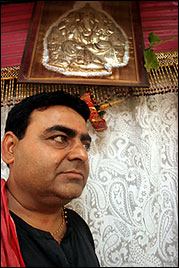
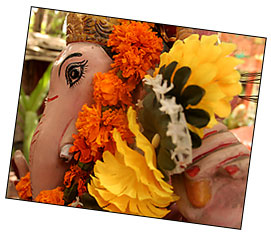 The
priest -- I'm not sure he's exactly that, more a temple manager
-- said his family had been on the banks of the river for six generations,
perhaps 150 years. His younger brother ran the wrestling school
started by their grandfather until the municipality demolished it
-- along with their air-conditioned home, their shop that sold coconuts
and flowers to pilgrims, their restaurant that served the onion-free
"satvik" food fit for holy occasions and two little temples -- last
August. Now the younger brother spends much of his time in court.
In the afternoons he teaches swimming at a local university.
The
priest -- I'm not sure he's exactly that, more a temple manager
-- said his family had been on the banks of the river for six generations,
perhaps 150 years. His younger brother ran the wrestling school
started by their grandfather until the municipality demolished it
-- along with their air-conditioned home, their shop that sold coconuts
and flowers to pilgrims, their restaurant that served the onion-free
"satvik" food fit for holy occasions and two little temples -- last
August. Now the younger brother spends much of his time in court.
In the afternoons he teaches swimming at a local university.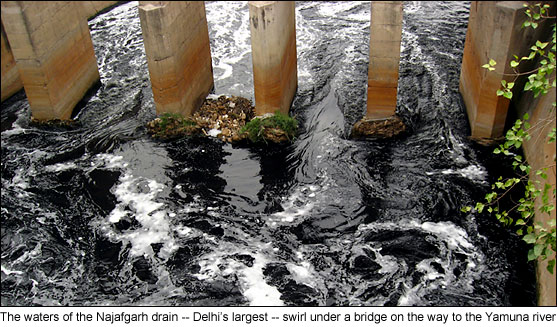
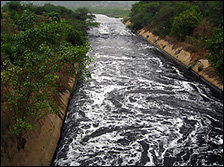 The
biggest of these drains is called the Najafgarh drain, for the neighbourhood
it passes through before joining the river. As its waters rush along
its cement channel, it seems a mighty river -- far mightier than
the Yamuna it is about to join. But these waters are black -- I
thought the river water was black last time but I erred, they were
more a soft charcoal shade -- a gleaming black flecked with white
foam.
The
biggest of these drains is called the Najafgarh drain, for the neighbourhood
it passes through before joining the river. As its waters rush along
its cement channel, it seems a mighty river -- far mightier than
the Yamuna it is about to join. But these waters are black -- I
thought the river water was black last time but I erred, they were
more a soft charcoal shade -- a gleaming black flecked with white
foam.